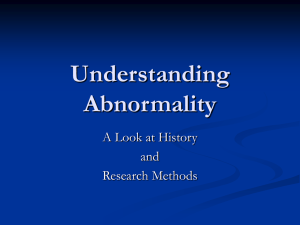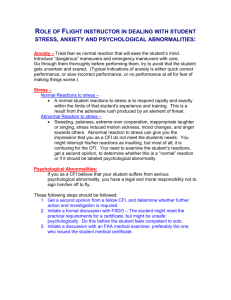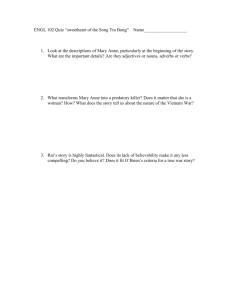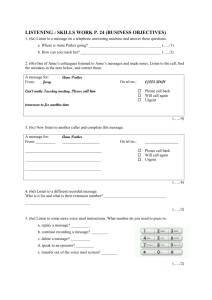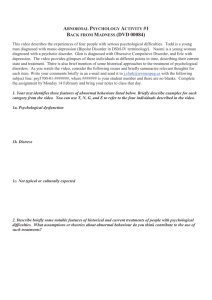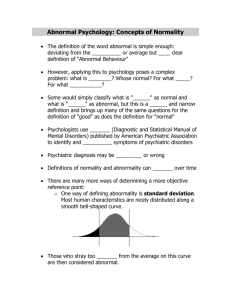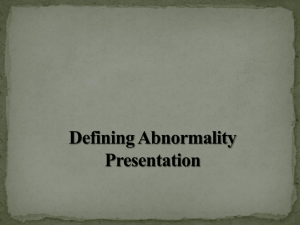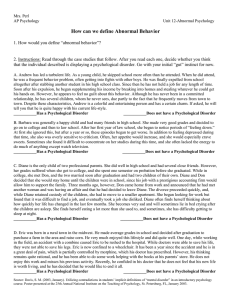Psychological Disorders
advertisement
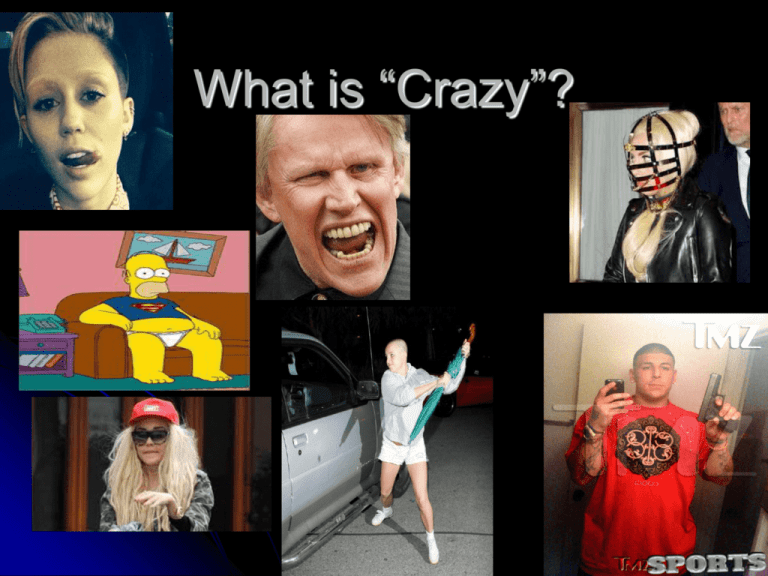
What is “Crazy”? Normal or Not? Story: A man living in the Ozark Mountains has a vision in which God speaks to him. He begins preaching to his relatives and neighbors, and soon has the entire town in a state of religious panic. People begin to say that he has a “calling.” His reputation as a prophet and a healer spreads, and in time he is drawing large audiences wherever he goes. However, when he ventures in St. Louis ad attempts to hold a prayer meeting, blocking traffic on main street at rush hour, he Is arrested. He tells the policemen about his conversations with God, and they hurry him off to the nearest mental hospital. Normal or not? Who is right…The man who believes he is a prophet, or the police officers? It Is often difficult to draw a line between normal and abnormal behavior. Behavior that some consider to be normal seems abnormal to others. Many people believe that having visions and hearing voices are important parts of a religious experience. Other people believe that these are symptoms of a psychological disorder. Normal or Not? The man in the example on the previous slide was interviewed by psychiatrists, diagnosed as paranoid schizophrenic, and hospitalized. Had he stayed at home, people would have continued to see him as perfectly normal – even popular… Defining and Identifying Psychological Disorders In the previous example, the man was classified as mentally troubled because his behavior was so different from what others felt was normal under the circumstances. Yet, the fact that a person is different does not necessarily mean that he or she is suffering from a mental illness. Deviation from Normality One approach to defining abnormality is to say that whatever most people do is normal. Abnormality, then, would be any deviation from the average or from the majority. Deviation from Normality The deviance approach, however, as commonly used as it is, has serious limitations. For example: If most people cheat on their income-tax returns, does that mean that the people who do not cheat are abnormal? Because the majority is not always right or best, the deviance approach to defining abnormality is not by itself a useful standard. Adjustment Another way to distinguish normal from abnormal people is to say that normal people are able to get along in the world – physically, emotionally, and socially. Basically, people who live by the rules of society. By this definition, abnormal people would be the ones who fail to adjust to society. What do you think? So what is right? Who is to say what issues constitute a psychological disorder, and what issues are merely minor variations from what is considered to be normal behavior? So, what does it mean to have a psychological disorder? Psychological Disorder-a harmful dysfunction in which behaviors are maladaptive, unjustifiable, disturbing, and atypical…M.U.D.A. M-maladaptive U-unjustifiable D-disturbing A-atypical Maladaptive Behavior Refers to types of behaviors that inhibit a person’s ability to adjust to particular situations and are destructive. People cannot adapt to what life gives them. They exhibit behavior that is destructive to oneself or others. Got any examples? Here is one Unjustifiable Without a rational basis Disturbing Behavior Troublesome to other people Atypical So different that it violates a norm Can you think of anything? How about this? Read these one and try to diagnose… A man walks up to a window, by or through which no one can see him, carrying a chair. He puts down the chair, opens the window, takes off his clothes, and seats himself on the chair. Why? He says he feels the need to take an “air bath.” Every morning, a woman who lives in a Boston suburb asks her husband to bring in the morning newspaper, which the carrier throws just inside their fence. She does this because she is terribly afraid of encountering a poisonous snake. Her husband, concerned about her behavior, repeatedly tells her that there are no poisonous snakes living in their town. Nevertheless, she is afraid to leave the house. A teenage boy packs a blanket and a bottle of water. Ignoring nearfreezing temperatures, he climbs a nearby mountain, spreads the blanket on the ground, sits crosslegged on it, closes his eyes, and remains there throughout the night. In the morning, he runs home and tells his father he has seen a vision. A teenage girl misses school for 3 days. She periodically breaks into tears. She finds it nearly impossible to get out of bed in the morning, although she cannot sleep for more than an hour or two at a time. She has no appetite and becomes nauseated if people urge her to eat. Last one… Anne is a sixteen-year-old girl living in a medium-sized city in the Midwest. Her family includes a mother, father, fourteen-year-old brother, and a great-aunt, who has lived with the family since Anne was four. Anne is a junior at City High School and is taking a college-preparatory program. Her appearance is strikingly different from the other girls in her class. She wears blouses which she has made out of various scraps of material. The blouses are accompanied by the same pair of overalls everyday, two mismatched shoes, and a hat with a blue feather. She is a talented artist, producing sketches of her fellow classmates that are remarkably accurate. She draws constantly, even when told that to do so will lower her grade in classes where she is expected to take lecture notes. She has no friends at school, but seems undisturbed by the fact that she eats lunch by herself and walks alone around the campus. Her grades are erratic; if she likes a class she often receives an A or B, but will do no work at all in those she dislikes. Anne can occasionally be heard talking to herself; she is interested in poetry, and says she is "composing" if asked about her poetry. She refuses to watch television, calling it a "wasteland." This belief is carried into the classroom, where she refuses to watch videotapes, saying they are poor excuses for teaching. Her parents say they don’t understand her; she isn’t like anyone in their family. She and her brother have very little in common. He is embarrassed by Anne’s behavior, and doesn’t understand her either. Anne seems blithely unaware of her apparent isolation, except for occasional outbursts about the meaninglessness of most people’s activities. How do we explain disorders? Medical Model of explanation Caused primarily by biological reasons We treat these causes through medicine, surgery, and ECT (shock therapy) Bio-Psycho-Social Model of explanation Caused by a combination of reasons (mostly psychological trauma) We treat with psychotherapy A Few Different Types of Disorders Anxiety Dissociative- (MPD) Eating Factitious Impulse Control- _____mania Nero cognitive Mood Nero developmental

